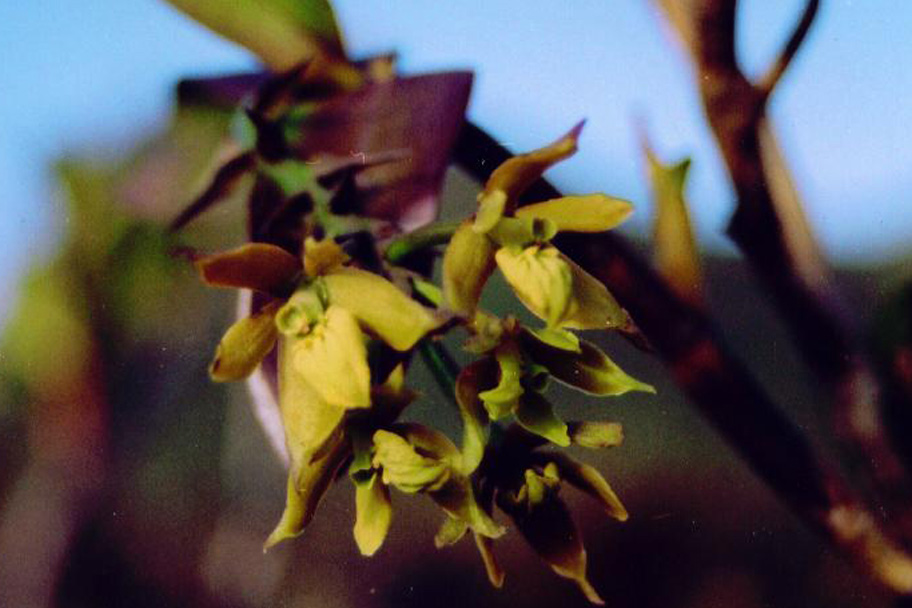

Epidendrum gentryi Dodson 1982 GROUP Alberti SUBGROUP Allenii
Photo by © Helge Vindenes and Flicker Orchid Photo Website©
TYPE Drawing by © Jimenez, Hágsater & E.Santiago and The AMO Herbario Website



 THROUGH MID
THROUGH MID
Common Name Gentry's Epidendrum [American Botanist mostly in Ecuador 1900's]
Flower Size 1" [2.5 cm]
Found in Ecuador in sphagnum moss banks in upper wet montane cloud forests at elevations of 860 to 2100 meters as a medium sized, warm to cool growing epiphyte or lithophyte with simple, cane-like, terete, slightly thickened towards the middle, slightly flexuous, sub-arching to erect stems carrying 5 in the apical half, alternate, elliptic, acuminate, entire marginally, articulate below into the base leaves that blooms in the spring through mid summer on a terminal, racemose, new racemes arise from the base of the primary racemose, suberect, ancipitose, elongate, 3" [7.5 cm] long, successively single, several flowered inflorescence enveloped completely by 7 tubular, imbricate, oblong-elliptic, obtuse, striated bracts and longer than the ovary, tubular, imbricate, oblong-elliptic, obtuse, striated floral bracts.
"Epidendrum gentryi belongs to the GROUP Alberti SUBGROUP Allenii , which is characterized by the caespitose habit, the slightly thickened stems with the leaves distributed throughout the apical half, the apical inflorescence somewhat shorter than the apical leaf and completely covered by imbricating bracts, the flowers produced successively, one at a time, with a very long clinandrium-hood. The species has partly spreading floral segments, the sepals .52 to .56" [13 to 14 mm] long, with the lip entire, widely-transversely ovate; the leaves are 2.4 to 8" [6 to 20 cm] long, the inflorescence is longer than the apical leaves; it is restricted to the Amazon slope of the Andes in Ecuador. Epidendrum lagenomorphum Hágsater & Dodson is quite similar and ranges along the western slope of the Andes in Colombia and Ecuador, has shorter floral bracts, narrower petals, and a proportionately longer clinandrium-hood, the body occupying only ¼ of the total length. Epidendrum ellipsophyllum L.O.Williams 1941 has the inflorescence slightly shorter than the apical leaves, and the flowers trumpet shaped, the apex of the .56 to .6" [14 to 15 mm] long sepals clearly reflexed, and the leaves 3.2 to 4.8 x .64 to .96" [8 to 12 x 1.6 to 2.4 cm]. It is similar to Epidendrum ellipsophyllum, which has somewhat smaller, straight sepals .4 to .52" [10 to 13 mm] long and much larger plants, with the leaves 4.8 to 8 x 1.12 to 1.98" [12 to 20 x 2.8 to 4.8 cm]. Epidendrum hygrohylephilum Hágsater & E.Santiago from coastal southern Colombia, has larger flowers with sepals .68 to .72" [17 to 18 mm] long, large, narrow leaves 3 to 7.6" x .48 to .94" [7.5 to 19 x 1.2 to 2.1 cm] and an ovate, unlobed lip, with the apical half triangular." Hagsater etal 2009
Synonyms
References W3 Tropicos, Kew Monocot list , IPNI ; Icones Orchidacearum 4 Plate 451 Hagsater 2001 see recognition section; Icones Orchidacearum 4 Plate 478 Hagsater 2001 see recognition section; Icones Orchidacearum 12 Plate 1250 Hagsater & Sanchez 2009 drawing fide; Native Ecuadorian Orchids Vol 2 Dodson 2001 as E cf gentryi photo ok; Icones Orchidacearum 15 [2] Plate 1579 Hagsater & Sanchez 2016 see recognition section; Orquideas, Tesoro de Colombia Vol 2 Ortiz & Uribe 2017
--------------------------------------------------------------------------------------------------------------------------